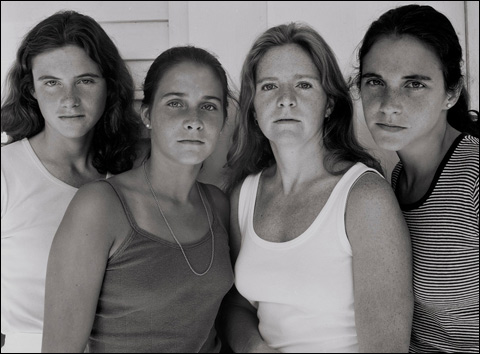
THE BROWN SISTERS (1978) Nixon’s annual group portraits of his wife (second from right) and her three sisters are always worth a second look. |
“Avedon Fashion: 1944–2000” | Museum of Fine Arts, Foster Gallery | through January 17 “Nicholas Nixon: Family Album” | Museum Of Fine Arts, Herb Ritts Gallery | through May 1 PHOTOS: Richard Avedon at the MFA. |
New-York-born-and-based photographer Richard Avedon (1923–2004), who's rightly credited with revolutionizing fashion photography, was more than a couturier-mag genius. A rarity in photography, Avedon evolved as a successful crossover artist who earned equally high reputations in fashion, portraiture, and documentary photography. He accomplished this by breaking the rules on all fronts, applying a journalistic/fine-art æsthetic to product-pushing images, and a commercial edge to work of more serious import. Lots of photographers dabble on both sides of the art/commerce fence, using commercial jobs to fund their higher-minded side projects, but Avedon never dabbled. He excelled — and, more important, innovated — in every field he entered.
"Avedon Fashion: 1944–2000," in the Museum of Fine Arts' first-floor Foster Gallery, is devoted exclusively to the evolution of Avedon's fashion shoots over six decades — from his self-initiated beginnings in the 1940s through his high-profile star turns at Harper's Bazaar and Vogue to his introspective career finale at the New Yorker. This is his commercial work; the ostensible subject is fashion, defined here as impractical and expensive clothing worn by people who look as if they'd never boarded a Mass Ave bus. Why are we taking this fluff seriously? After all, Avedon also documented the second half of the 20th century with iconic and revealing portraits of the likes of Marian Anderson, the Chicago 7, Truman Capote, Henry Kissinger, and Patti Smith, and he shot such cultural touchstones as the Beatles' White Album poster and Simon and Garfunkel's Bookends cover. He even did a 1994 publicity still for Megadeth.
The answer lies not in the content of the MFA's photos — which, bluntly put, is attractive people in outlandish costumes posing for photos commissioned to decorate the pages between the ads selling more realistic and affordable items in glossy fashion magazines. No, the answer is that Avedon's fashion photography, though always fulfilling its commercial purpose, stands apart from its genre — not quite fine art, perhaps, but certainly something more than product shots.
In the post–World War II scramble for fun and prosperity, Avedon introduced elements to fashion photography that we now take for granted. He juxtaposed his models in designer get-ups with unlikely props, animals, celebrities, and locations. For most viewers, the couture, though always top-of-mind for Avedon, takes a back seat to the gags and concepts. Dovima, a frequent Avedon model whose self-manufactured name and mystique cloaked her Queens (New York) identity of Dorothy Virginia Margaret Juba, postures gracefully aloof though flanked by elephants. Audrey Hepburn clowns beside an attentive Art Buchwald at the bar at Maxim's in Paris. Dovima and actor Ray Bolger meet at the same location, with Buster Keaton wearing an Indian headdress at the end of the bar. Model Suzy Parker and director Mike Nichols lampoon paparazzi-beset celebrities in Paris.